webOS review - Smartphone Round Robin
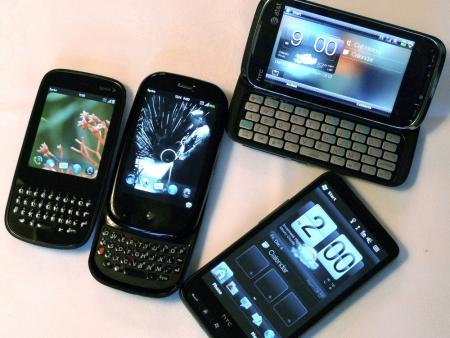
Myriad metaphors come to mind when thinking about Palm and Microsoft. David and Goliath. A young upstart fighter who took a couple of punches, versus an aging but still powerful opponent. A young executive overtaking the old man in the corner office. Take your pick.
In the past year, Palm announced and delivered on a new (and some say revolutionary) operating system and a pair of new phones. Microsoft announced and delivered another iteration of its operating system, which has found itself on a number of new devices. Their stories parallel each other, though many say the companies and their platforms are traveling in opposite directions.
After the break, we go in-depth with Palm's webOS from a Windows Mobile perspective, Smartphone Round Robin-style.
One company exits the desert, another enters
First, a bit of background. It was just a few years ago. Palm's Garnet operating system, beloved by many, was aging. No successor was in sight. The OS side of Palm was sold off, an infamous gaffe in technology history. The Foleo, a netbook before netbooks were netbooks, was unceremoniously put down. The stock dropped, and dropped, and dropped.
Recognizing a new direction was needed, Palm circled the wagons and went dark. Months and months went by, and new investors came in. A couple new Palm OS Treos were released, as well as some decent Windows Mobile Treos. But that wasn't going to get the job done, and everyone knew it. In early 2009, webOS was announced. It was be based on the language of the Internet, and the Palm Pre, a river stone-shaped device with a flush touchscreen and vertically-sliding keyboard, would carry the flag.
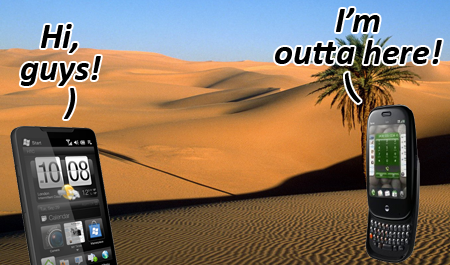
Around the same time, Microsoft announced Windows Mobile 6.5, and not Windows Mobile 7, which had been long rumored but never seemed to get off the ground. WinMo 6.5, as it's commonly called, was build on its predecessor, Windows Mobile 6.1; which was build on its predecessor, Windows Mobile 6.0; which was built on its predecessor, Windows Mobile 5. And so on an so forth. Eyes rolled. Mouths yawned. A bit unfairly, but the sentiment was felt far and wide. This was not going to wow the masses. As of this writing, Windows Mobile 7 still has not been announced. And it may well be another year before it reaches consumers.
One company moves forward. The other, if not moving backward, certainly seems to be spinning its wheels.
All the latest news, reviews, and guides for Windows and Xbox diehards.
webOS and Windows Mobile 6.5
Palm's new operating is devilishly simple. At its core is Linux, the open-sourced OS found in just about everything these days, it seems. But the key to webOS is that to develop for it, you need only know such tools as HTML and Javascript, the basic building blogs of the Web site design. If you can build a Web page, you can develop an app for webOS. It also means that webOS is easy to tailor to phones with different resolutions, like when a Web browser is resized. Windows Mobile, on the other hand, has a massive chart of all the screen permutations. It's daunting.
Graphically, webOS is striking and subtle at the same time. It's totally different than the previous Palm OS. But you can still feel that Palm was behind it.
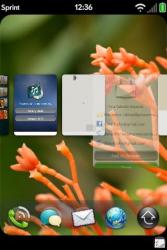
Being based on basic Web code is great, but really useful for most of us. Where webOS really shines is in app management. Windows Mobile users are used to wanting to exit applications. It's in our DNA. If an app's open and we don't need it? Close the sucker. Palm's made multitask effortless with its "cards" metaphor. Think of open applications -- actually more than just apps: anything at all you have running -- as playing cards. With a single touch you can show the deck, switch to a different card, or swipe up to toss it away, thus closing the app. That, and ease of development, truly are where webOS shines.
Ah, but there's an Achilles' heel. Because webOS is HTML-based, programmers can't do some of the deep-level coding that makes apps on other platforms so powerful and immersive. And webOS is still in its infancy, and programs don't have access to some of the core parts of the phone's database. It also still is not using any of the graphics power it has waiting under the hood. This is not to say webOS is lacking, but at the moment it is limited. We'd expect Palm to open things up at some point. It's just that they haven't yet.
Beyond the nuts and bolts, webOS is very intuitive. It will take a little learning, but it's far from intimidating. And once you understand the card metaphor and have the basic gesture inputs for bringing up menus and moving things around (and these are very simple inputs), you'll be dealing seconds just like the best in Vegas.
Hardware

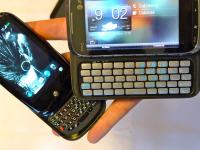
Palm has two new phones. Windows Mobile 6.5, released in October, is on a good handful (and Windows Mobile 6 and 6.1 are on dozens of devices). For the Round Robin, we paired the Palm Pre (the first webOS device) and Pixi (newer and smaller) up against the HTC Touch Pro 2 and HTC HD2. At first we're inclined to declare this an unfair fight. The Pre and Pixi are dwarfed by their WinMo counterparts. (Hell, everything is dwarfed by the HD2 with its 4.3-inch screen.)
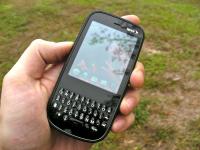
What we have are vastly different form factors. The Pre is a vertical slider, meaning the keyboard comes down from behind the touchscreen. Its processor is speedy, but the phone can get bogged down if too many programs are open.The Pixi has a front-facing keyboard, with you all the time. Both have capacitive touchscreens, which recognize touch inputs better than the resistive screen on the Touch Pro 2. The HD2 is just a hulking monster. Its humongous capacitive screen and 1GHz Snapdragon processor mean it's not lacking for size or speed.
The only real knock on the Pre and Pixi are when it comes to size. The Pre's 3.1-inch screen is usable, but needs a size increase. the Pixi is just tiny, and it's lacking in processing power. For a first-time smartphone user, that may be OK. But considering the Pre can be purchased for just a little more money ($50 more is the norm), it's really a no-brainer. But those things aside, the Pre and the Pixi really are better than the sum of their parts. They just feel good in the hand and fit the overall feel of the Palm and webOS experience.
The app experience
"Yeah, but does it have apps?" Does webOS have apps? Look, on Windows Mobile, we're used to tens of thousands of apps that can be loaded anytime, anyplace. Microsoft finally launched the Windows Marketplace for Mobile in October 2009, starting to bring things together (though by no means was it the first repository for Windows Mobile programs).
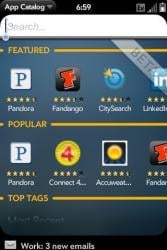
On webOS, at least at first, you were stuck with what Palm gave ya. But nerds will be nerds, the Pre quickly was hacked open to allow new and unofficial (as in not yet sanctioned by Palm) apps. "Homebrew" was born. Our own PreCentral.net is a major player in the Homebrew world, serving up (as of this writing) nearly 390 apps, which have been downloaded more than 4.6 million times. Homebrew is not a fad.
An app store is an app store is an app store. Apple might have done it first (and many would say best). But others quickly caught up, and the official Palm App Catalog sports more than 800 apps at the moment. The WinMo Marketplace sports 462, but that's a U.S.-only number and fluctuates in other nations. Both stores are easy to maneuver and are easy to download from. And, really, that's as important as the phone being used. Palm has a lot of momentum behind webOS. The trick will be maintaining it.
Availability
Like we said, Windows Mobile is available everywhere. On all major (and most other) U.S. carriers. In a variety of form factors. Horizontal slider? Got it. Hulking black slab? Sure. Want one with a kickstand and mobile TV? No problem. The sky's the limit. The Palm Pre and Pixi? Currently only available on Sprint, with which Palm has had a special relationship for some time. But Palm needs growth. It needs to get as many phones into the market as it can right now. And there are countless consumers waiting to buy, once Palm comes to them. That's a big bag of hurt right now.
Oh, and by the way, webOS killed off the Windows Mobile Treo. We're still smarting over that one.
Usability and the wrap-up
I like to say that if you can use Windows Mobile -- as in really use it -- you can use any other mobile OS out there. And that rings true for Palm's webOS. App management is a breeze. The Web browser is top-shelf. For e-mail, Palm has Synergy, which can cull contacts from a number of sources -- Exchange accounts, gmail, Facebook, etc. Multimedia? Yeppers. Chances are if you need to do something, there's, ahem, an app for that.
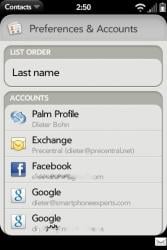
Could I live with webOS for a week? Absolutely. A month? Sure. Really all it's missing right now is a bigger audience, and that should change in the coming months. Verizon is the likely suspect, but AT&T and T-Mobile are possible contenders, too.
Palm has been known as the kinder, gentler platform, and that remains true today. Your family can use it. Your friends can use it. Windows Mobile 6.5 is less utilitarian than its predecessor, and we're looking at it to become even more friendly with Windows Mobile 7 in 2010. That could well give Palm a run for its money in the consumer space. As for Palm in 2010? It has to get more hands on its phones. And while the Pre is only six months old, attention spans are short in the mobile world. As Palm's meager empire expands once more, it's going to need new hardware to go with it. Certainly there's already something in the works.
Palm has all of the pieces on the board in front of it. And it's calculating and executing moves months ahead. Microsoft has pulled back and is shuffling its deck once more. Finally it realized that what it was putting out wasn't competitive (despite its following). Can a company the size of Microsoft stop what it's doing, retreat to Redmond, Wash., and start anew, like Palm did with webOS, the Pixi and the Pre? Perhaps. But Palm finished its time in the desert much sooner than Microsoft began its trek. What will Palm bring in 2010? And will Microsoft be able to meet it, in mind share as well as future market share?
News at 11.
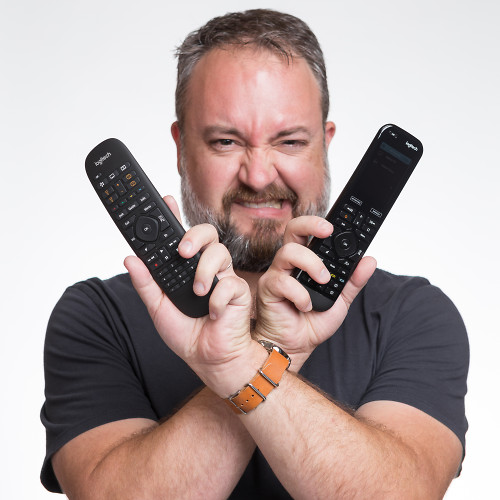
Phil is the father of two beautiful girls and is the Dad behind Modern Dad. Before that he spent seven years at the helm of Android Central. Before that he spent a decade in a newsroom of a two-time Pulitzer Prize-finalist newspaper. Before that — well, we don't talk much about those days. Subscribe to the Modern Dad newsletter!
